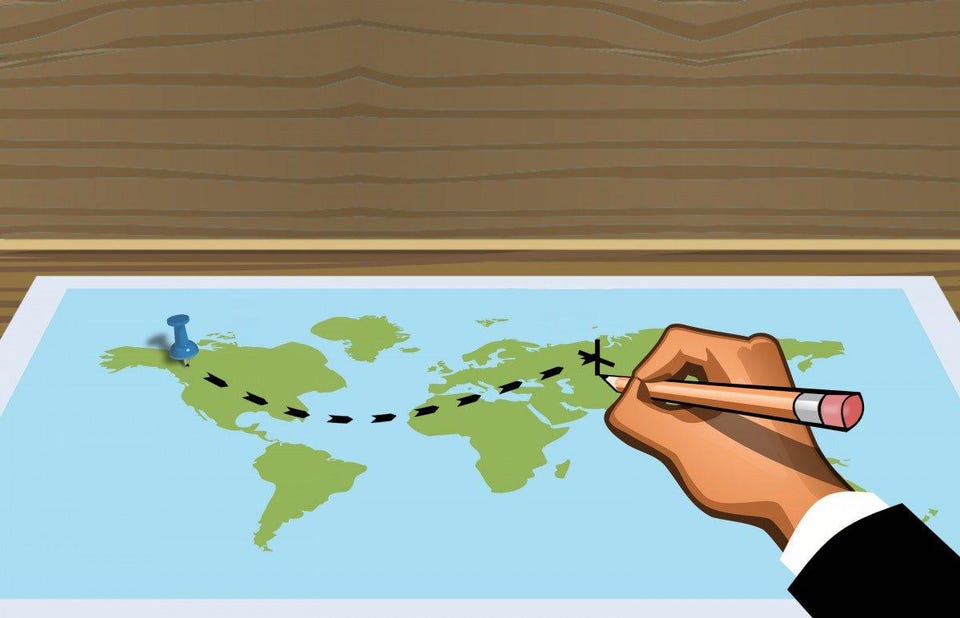The mathematically correct way to tie your shoes

- One of the great accomplishments of early childhood comes when we successfully learn how to tie our own shoes: making a "bow" for the first time.
- The mathematics of knot theory, however, teaches us that there are two topologically different types of "bow" we can make, and one is much more unstable than the other.
- For 29 years, I myself tied my shoes in the dreaded "granny knot" style, and my laces would chronically come untied. Here's the mathematics of why, plus how to do it right.
One of the major milestones of our early childhoods comes when we learn, for the first time, how to successfully tie our own shoes. As most of us learned, there are three key steps to making that happen:
- First, a criss-cross and tuck.
- Then, hold one side of your laces in a loop.
- And finally, wrap the unlooped lace around the loop and pull it through.
Do all three steps correctly, and you’ll wind up with a successfully tied shoe.
Or will you?
As it turns out, there are two possible mathematical outcomes that arise from following all three of these steps successfully. You can wind up with a tied shoe that won’t come untied throughout the day, even after thousands of steps, with a “bow” that sits nice-and-square atop the shoe itself. Or, alternatively, you can wind up with a shoe that appears tied, but whose knot invariably wants to “twist” at an angle, and that will frequently come undone even with relatively light daily use. You aren’t just unlucky if you fall into the latter category; you’re probably tying your shoes in a fundamentally incorrect fashion. Mathematics explains why.

There are many branches of mathematics that explore the relationships between various quantities. The earliest mathematics that most of us learn involves numbers and some basic mathematical functions: addition, subtraction, multiplication, and division. At more advanced levels, we learn about shapes and geometry, then algebraic expressions, sequences and series, trigonometry, and then, perhaps, calculus.
But there are many more branches of mathematics than these. One branch of mathematics is topology, which concerns itself with the properties of a geometric object that are and aren’t preserved when they’re deformed and distorted. Most of us play with this a little bit when we’re young: creating Möbius strips with paper, scissors, and tape.
One area of interest within topology is known as knot theory, which studies various types of knots that relate to the geometry of position. But knots themselves, such as in rope and shoelaces, date back to prehistoric times: well before any formal mathematical study took place. While humans have been interested in knots for aesthetic and spiritual purposes, as well as for recording information, their most common use is simply to tie objects together.

There are many different types of knots, but their utility comes about because of two different properties that they possess.
- When you either pull on them or stress them in a particular fashion, they tighten and become more secure.
- However, when you pull on or stress them in a different fashion, they can come undone entirely.
From slipknots to nooses to bowlines and more, the difference between a successful knot and an unsuccessful knot can lead to a minor inconvenience (such as if your shoelaces come untied) or to a life-or-death situation (such as if your knot comes undone while rock climbing).
Although most of us rarely think about it, the act of tying our shoes actually involves three important decisions that we make. The cumulative effects of those three decisions determine whether we get the “good knot” (a reef knot) that will tighten as we walk and jostle it, but that will easily come undone if we pull on one of the lace ends, or the “bad knot” (a granny knot) that will loosen and eventually come undone as we walk and jostle it, while still coming easily undone if we pull on either of the lace ends.

If you’re wearing shoes right now, this is something you can tell simply by looking at them. Look at the bow in your shoes, and notice how it sits.
- Does the knot sit “squared up” above your shoelaces, do the loops want to orient themselves horizontally across your laces, and if you try to move them to an angle in either direction, do they revert to that horizontal position?
- Or does the knot twist at an angle above your laces, do the loops want to twist to the side at a severe angle rather than sit horizontally across your laces, and if you try to move them to an angle to the horizontal, are they happy to remain there?
If you’re in the first camp, you’ve likely tied a good (reef) knot that will remain tied all day long. If you’re in the second camp, you’ve likely tied a bad (granny) knot that will come undone at some point throughout the day. Some people, in an attempt to mitigate a bad knot, have adopted the tactic of simply “double-knotting” their shoelaces, but even that is often insufficient to keep them from coming undone throughout the day. (This also applies to any bow tie-wearers out there. If your bow tie wants to twist at an angle, you’re probably granny-knotting it without even thinking about it!)
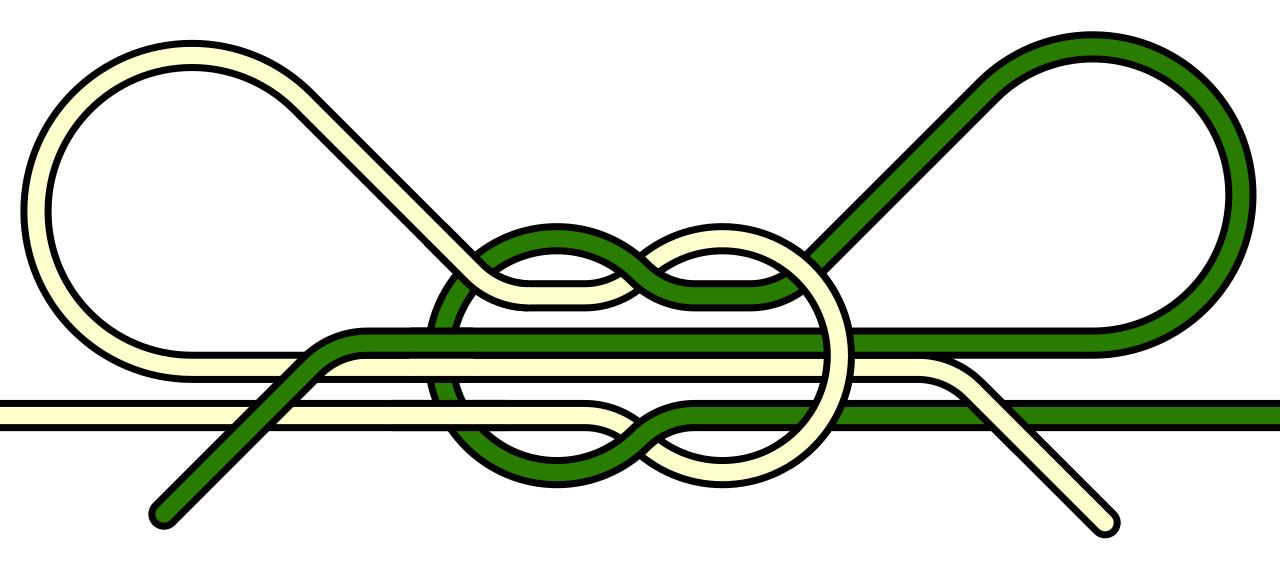
In the case of a good knot, one lace comes in from the side, loops over the other (incoming) lace, its own (outgoing) lace, and the “loop” of the other lace, before looping under-and-through the other lace, making its own looping half-a-bow, and looping through the center of the “knot” in both laces. The same is true of the opposite lace. Now, take note of the following three aspects of this knot:
- Note how there are the two big loops that, when you pull on them, will tighten the bow and pull the knot tight on itself.
- Note that if you pull on either loose (outgoing) end of the laces, you’ll undo the bow and successfully untie your shoes.
- But most importantly, note also that if you pull on either of the two “incoming” laces, this will further tighten the knot that holds the bow together.
It’s this third aspect that is different for the good (reef) knot and the bad (granny) knot. Those forces on the incoming laces, which get exerted every time your foot pulls on the laces from the inside, will tighten the knot if you’ve tied a good knot, but will inherently loosen the knot if you’ve tied a bad knot.
From a topological perspective, there are three steps that you take when you tie your shoes, and each step has a “choice” that you make. All told, there are eight possible outcomes: four of which give you a good (reef) knot and four of which give you a (bad) granny knot. Here’s how to mathematically tell which one you’re creating, as well as how to fix it if you’re doing it wrong.
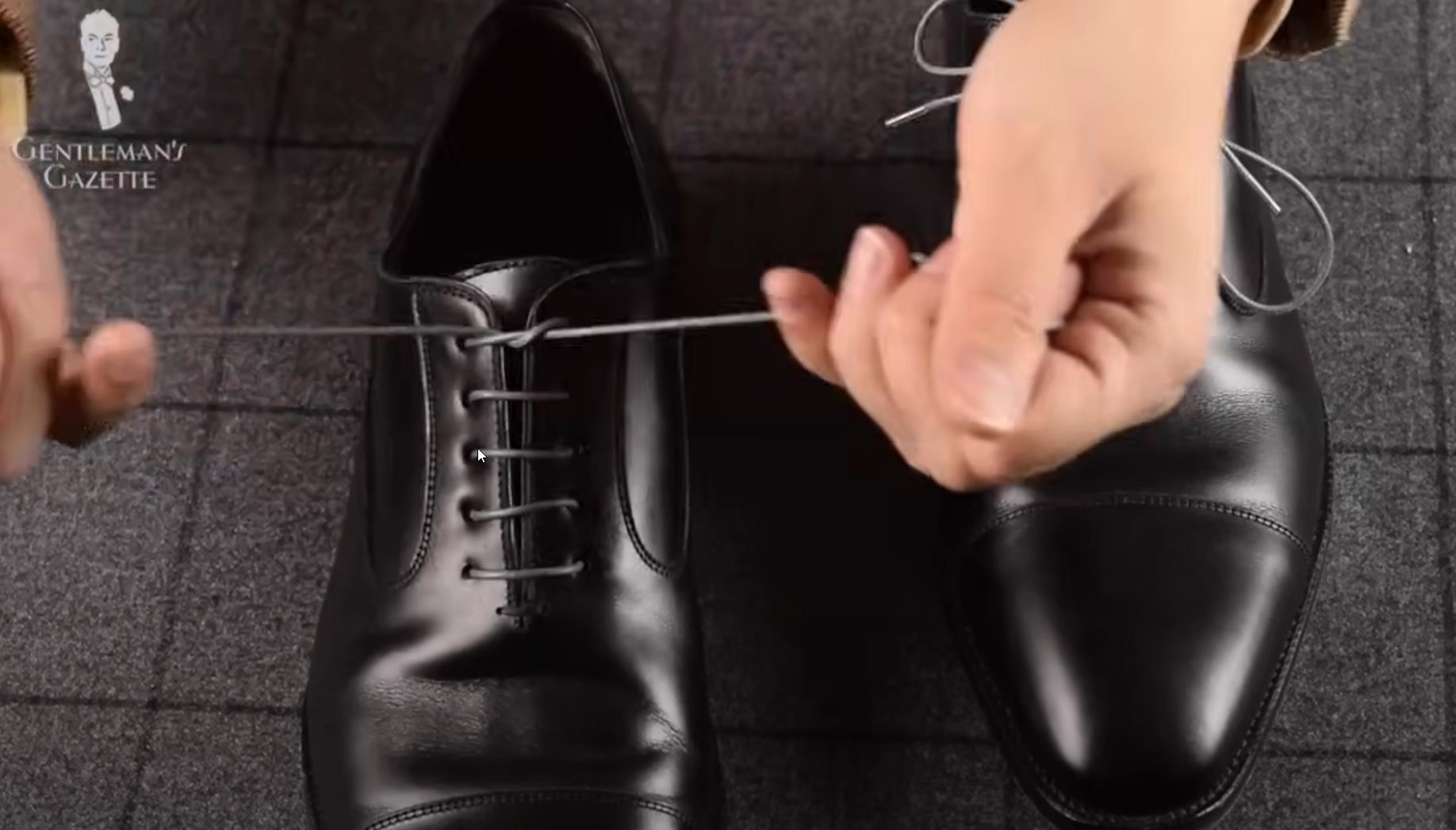
Step #1: The criss-cross and tuck.
When most of us tie our shoes, we first take the two sides of our shoelace in our left and right hands, and pull them taut, so that there’s lots of free lace and that they’re approximately the same length. Then, what we do is what I learned as “cross-cross and tuck,” which involves:
- crossing the laces together,
- tucking one lace under the other,
- and then pulling them tight,
creating the base of our shoelace bow.
We don’t often think about what we’re doing when we take this step, but we make one of two decisions when we tie our shoes.
- Either we cross the left lace over the right lace before tucking it under and pulling both ends tight.
- Or we cross the right lace over the left lace before tucking it under and pulling both ends tight.
I don’t have any science to back it up, but in my experience, left-handed people typically default to the first option, and right-handed people typically default to the second option. Neither one of these options are right or wrong, as both of them can lead to either a properly or improperly tied shoe. Which one you wind up with all depends on what you do with your next two steps.
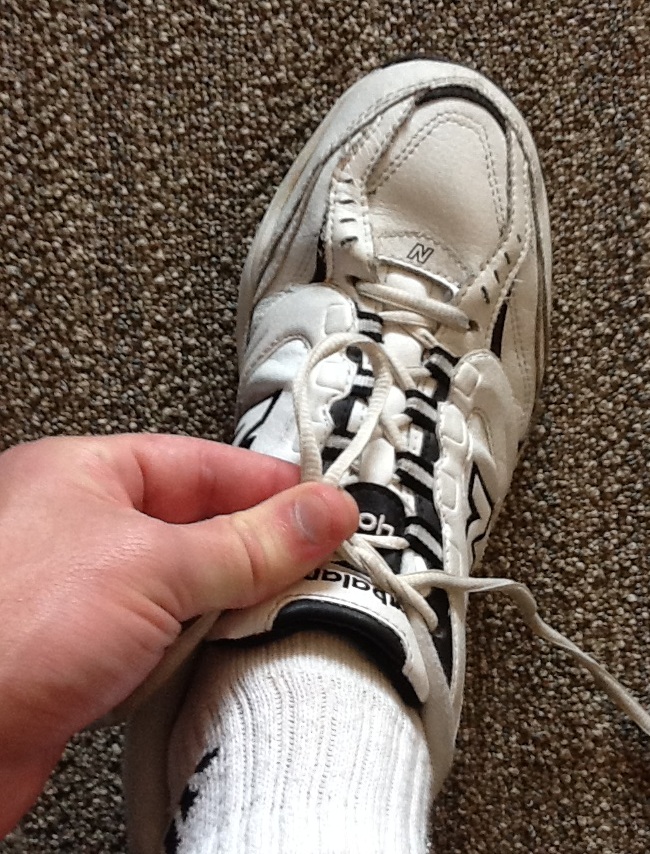
Step #2: Make a loop with one of the two sides.
Once you complete the first step, you now have two “loose ends” to your laces: one on your right side and one on your left. Now, you’ve got a choice to make. You’re going to make a loop out of one side of those laces, and then wrap the other lace around that loop before pulling it through.
But which side will you choose to make the loop out of?
- Either you grab the lace that’s on your left side with your left hand and create a loop with it.
- Or you grab the lace that’s on your right side with your right hand and create a loop with it.
Again, I have no data to back this up, but if you’re left-handed, there’s a good chance that you’ll want to leave your left hand free to deal with the more complicated step 3 that’s coming up, and so you’re likely to choose option #2, and make the loop with your right hand. Similarly, if you’re right-handed, your default may be to leave your right hand free for step 3, and so you may grab the left lace with your left hand and make a loop with that, choosing option #1.
Again, neither option is inherently right or wrong, but based on what choices you made for step #1 and step #2, the choice you make for step #3 becomes all-important.

Step #3: Wrap the unlooped lace around the loop and pull it through.
And now, to finish tying your shoe, all you have to do is wrap the (unlooped) lace around the loop you just created, and then pull the lace through. Then you can pull on both loops to complete the bow (assuming you don’t accidentally pull one of your loops apart), and now your shoe is tied!
But is it tied correctly?
It depends on which of the two options you chose for wrapping the (previously) unlooped lace around the loop you made in step #2.
- Either you wrapped the unlooped shoelace underneath the loop and then up and back toward you before pulling it through.
- Or you wrapped the unlooped shoelace over the loop and then down and around back toward you before pulling it through.
Although, to my knowledge, it has never been studied, which path you take exhibits no preference among right-handed or left-handed people; it’s completely random. And yet, depending on the choices you made for step #1 and step #2, one of these options will give you a correctly-tied shoe with a good (reef) knot in it, and the other option will give you an incorrectly-tied shoe with a bad (granny) knot in it. Most people tie both of their shoes in one way or the other, but there are a few people who get one good knot and one bad knot in their shoes, as they tie their left and right shoes according to different algorithms.

So, what are the correct and incorrect ways to tie your shoes, mathematically? I’ve made a handy infographic (below) to help guide you through the outcomes of all eight possibilities, but the following list can also show you whether you’re doing it correctly or not.
- Cross left over right and tuck, loop with the left lace, wrap right lace over the loop and pull: reef knot.
- Cross left over right and tuck, loop with the left lace, wrap right lace under the loop and pull: granny knot.
- Cross left over right and tuck, loop with the right lace, wrap left lace over the loop and pull: granny knot.
- Cross left over right and tuck, loop with the right lace, wrap left lace under the loop and pull: reef knot.
- Cross right over left and tuck, loop with the left lace, wrap right lace over the loop and pull: granny knot.
- Cross right over left and tuck, loop with the left lace, wrap right lace under the loop and pull: reef knot.
- Cross right over left and tuck, loop with the right lace, wrap left lace over the loop and pull: reef knot.
- Cross right over left and tuck, loop with the right lace, wrap left lace under the loop and pull: granny knot.
With three either/or decisions to affect the configuration of your knot, these eight total possibilities can lead to either a reef knot (which is good) or a granny knot (which is bad), all dependent on which combination you choose.
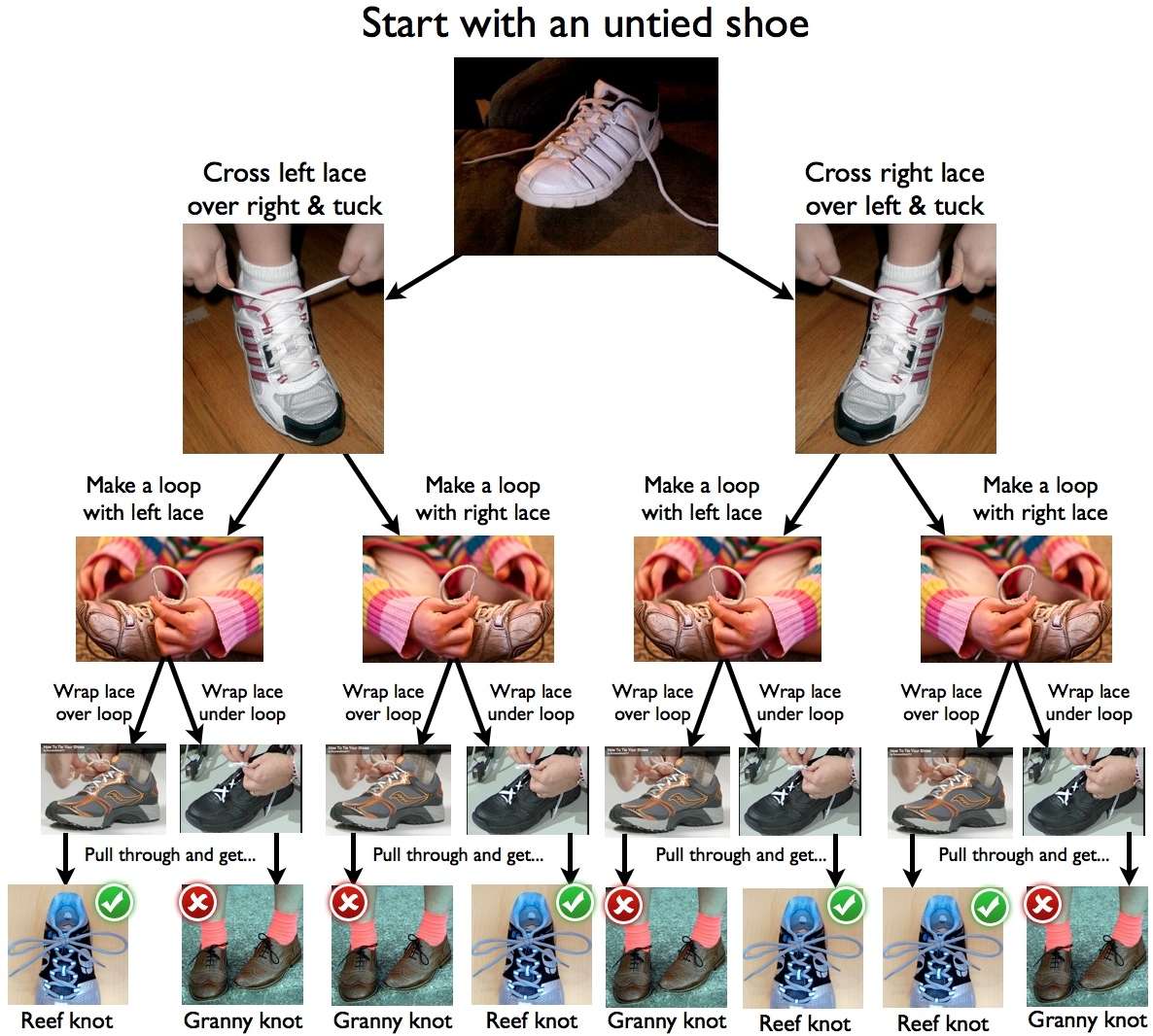
If you’re one of the unlucky people who discover you’ve been tying your knots wrong for all of this time, don’t despair. This is a fixable problem, and the easiest way to fix it is to change one of these steps: any one you choose. The hard part will be re-training your brain, as even if you’re a young reader of this article, you’ve likely been tying your shoes the same way, over and over again, for many years, perhaps a total of thousands or even tens of thousands of times.
The important fact to keep in mind is that you likely already know all three of the steps to correctly tying your shoes. Whether you’ve been tying them correctly or not is likely a 50/50 proposition, as very few people receive guidance when they’re young as to the difference between a reef knot and a granny knot, and to whether the method you’re using for tying your shoes is giving you a good knot or not.
So don’t be embarrassed if you’re one of the many who have been tying your shoes in a mathematically incorrect fashion all along. Chances are good that you’ve never been taught how to do it correctly, or what the difference between “correct” and “incorrect” even means. Now that you know, may successfully tied shoes be your constant companion for the rest of your days!
Disclosure: Ethan Siegel, the author of this piece, is left-handed and tied his shoes incorrectly for 29 years of his life, from age 4 through age 33. He advises you not to be surprised if re-training your brain to tie your laces correctly, by default, takes several weeks of consistent and conscientious practice.




